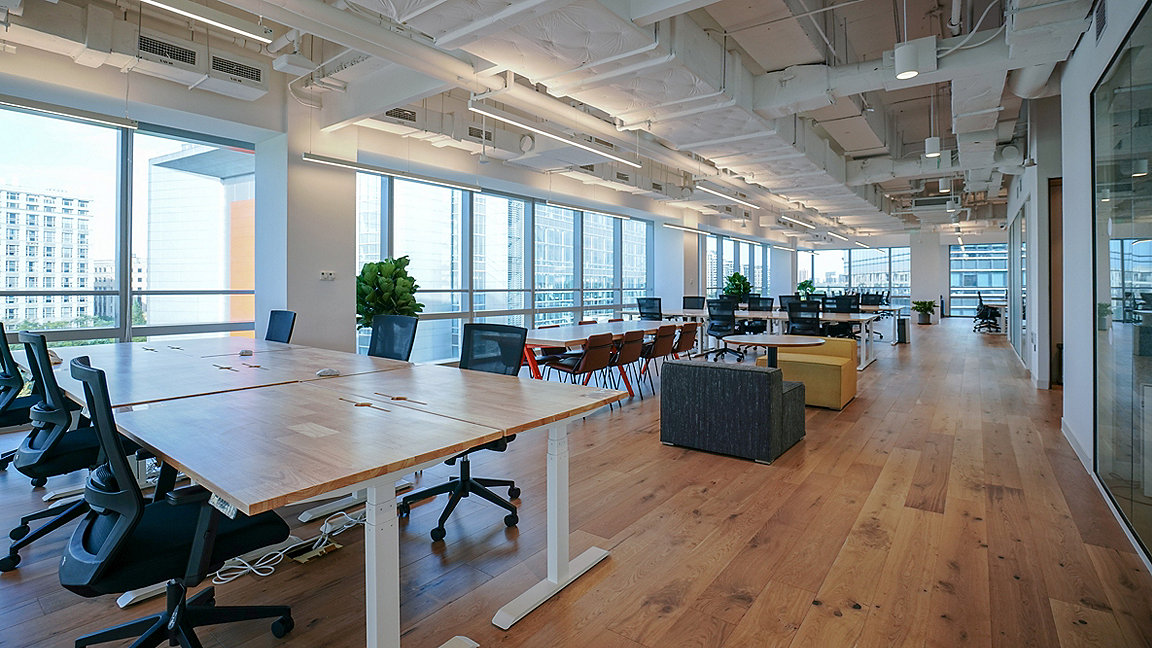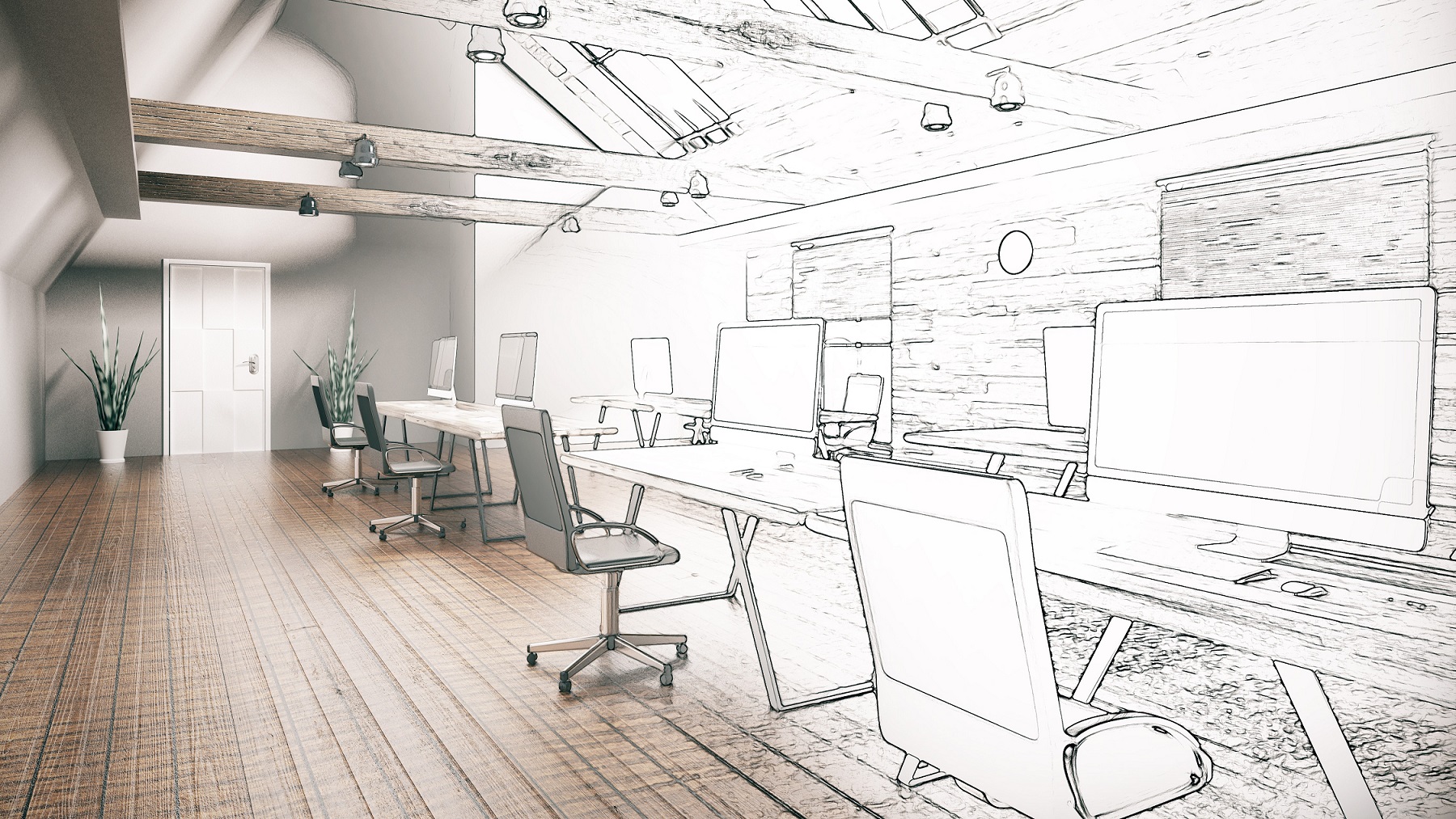
There is still understandable concern among the workforce about exposure to COVID-19 and staff have been slow to return to the office – even as restrictions have eased, according to the Property Council of Australia.
Many employees have also concluded that their work–life balance has improved because they no longer need to commute. They have questioned whether the Monday-to-Friday, nine-to-five model will resume, or indeed whether people are comfortable working in shared offices. By late 2021, research found that only 40% or so of all global office workers had returned to the office.
Comparing traditional and flexible layouts
Traditional and flexible office layouts each have their advantages and disadvantages.
The former may help staff concentrate, enabling privacy when needed as well as motivators such as the ability to form friendships and workplace bonds as colleagues work in close proximity to one another, hygiene and the ability to personalise workstations.
However, working in such an environment may make it more difficult to connect with colleagues and the wider organisational culture – especially for those who started or switched jobs during the pandemic.
In contrast, unassigned, flexible office layouts may increase employee productivity by improving opportunities for collaboration, and meeting the psychological needs of professionals in the knowledge economy, including freedom over when, where and how to work. However, flexible offices have their own limitations such as lack of privacy, lack of personalisation in non-territorial spaces, requirement for repeated log-ins and searching for a free place, and more time spent on organising work.
The question is, then, which office layout arrangement works best, and has this changed since the pandemic?
Assessing activity-based working
Clearly, the answer will vary between sectors and organisations.
Before COVID-19, the growth in flexible working practices and increasing corporate real-estate costs meant that organisations had increasingly introduced adaptable, non-territorial layouts. However, the full effects of these, and their attendant changes for employees, are not well understood.
With this in mind, our team of researchers at RMIT University in Melbourne and the University of Technology Sydney set out to examine how organisational cultures changed in Australia with the introduction of activity-based working (ABW), from the perspectives of employers and employees alike.
ABW provides spaces for various activities that employees perform, rather than rigidly allocating space according to hierarchy. Different types of workstation, room and area are designed to support a specific kind of activity; for example, there are dedicated places for collaboration, concentration, communication, creativity, confidentiality and contemplation.
'Unassigned, flexible office layouts may increase employee productivity by improving opportunities for collaboration, and meeting the psychological needs of professionals in the knowledge economy, including freedom over when, where and how to work'
Table 1: Organisational types and characteristics in the Competing Value Framework
|
Culture type |
Key characteristics |
|
Hierarchy |
|
|
Market |
|
|
Clan |
|
|
Adhocracy |
|
Interviews and surveys garner insight
To understand the employers' perspective, we focused on finance and IT companies in the private sector and government departments in the public sector. We conducted in-depth interviews with 32 large organisations that had moved from traditional offices to ABW between 2012 and 2019. All participants held senior managerial level positions and were directly responsible for the decisions on their workplaces and people and culture-related matters. Topics discussed included the motives for doing so, the main requirements for the new layout, and organisations' perceptions and experience of how this had affected the existing corporate culture.
In terms of employees, we surveyed staff in one organisation from each of the three sectors that had introduced ABW over the same period. We received 223 completed surveys, with a 28% response rate.
The Competing Value Framework – a common way of distinguishing different culture types – was used to measure the impact of layout changes from both employer and employee perspectives. The different dimensions of this framework and their characteristics are summarised in Table 1.
To gauge how far organisational culture changed, employers and employees alike were asked how far they thought each type characterised their organisation before and after introducing ABW. Their responses were measured using a nine-point scale, where the number one signifies that a culture type had no place at all, and nine indicates that it has an extremely high presence.
Bureaucracy transitions towards clan culture
In our sample, all staff originally occupied static desks or offices, and their assigned spaces were often sized and equipped according to their status, which was mainly based on hierarchical or bureaucratic culture.
The bureaucratic work theory, which suggests that work is best done by being broken down into its simplest parts, was gradually being replaced by the concept of management by objectives, which is based on the notion that organisations are greater than the sum of their parts. Research by CBRE has found that the role of the office is moving away from an intentional work setting to instead be collaborative and create meeting spaces which have the ability to bring people and teams together, particularly after the pandemic. With increased communication, collaboration, information sharing and knowledge integration in these workplaces, the presence of other culture types such as clan, market and adhocracy has noticeably increased.
All 32 employers interviewed emphasised that they had observed obvious changes in their corporate culture with the introduction of ABW. They strongly believe that workplace design directly influences their organisational culture by supporting the systems, engagement, motivation and behaviours of their organisation and employees.
With layout changes, both public- and private-sector organisations believe that clan culture became dominant. Table 2 summarises the organisations' perceptions of the culture that existed before and after introducing ABW.
Table 2: Organisational culture types before and after layout changes
|
Culture type
|
Public sector
|
Private sector
|
||
|
Before ABW
(mean score)
|
After ABW
(mean score)
|
Before ABW (mean score)
|
After ABW (mean score)
|
|
|
Adhocracy
|
4.6
|
5.9
|
5.6
|
7.3
|
|
Clan
|
5.4
|
7.5
|
5.6
|
8.2
|
|
Hierarchy
|
6.6
|
7.0
|
5.8
|
5.8
|
|
Market
|
6.1
|
6.7
|
6.5
|
7.9
|
As Table 2 shows, private-sector employers reported a higher presence of clan culture after introducing ABW. This may be due to differences in goals in private and public-sector organisations. The former largely pursue profit alone, while the latter have multiple goals and are exposed to greater external scrutiny. As a result, it may be easier for private-sector organisations to change their structural arrangements to achieve their goals.
The survey revealed that private-sector employees in finance and IT perceived that clan culture increased considerably after moving into ABW settings. Consequently, flexibility, collaboration, participation and consensus also increased, while maintaining competitiveness.
Interestingly, public-sector employees believe the culture of their organisation did not change much after the introduction of ABW, and that hierarchy remained dominant. This suggests that, even in flexible office layouts, public-sector employees feel that standardised procedures govern their actions, and they have minimal discretionary powers.
Finance shifts to collaboration to meet same goals
Of all the sectors, organisations in finance were found to experience the most significant culture changes from both employer and employee perspectives. Market culture, which is built on competition, was dominant in the sector before ABW, followed by hierarchy, with clan and adhocracy third and fourth respectively.
The predominance of market culture was due to financial sector organisations' focus on enhancing profitability and market share, with strict institutional procedures in place to maximise profits. Traditionally, collaboration and innovation were less important in this sector.
However, with the introduction of ABW layouts, clan culture became dominant, with significant increases in collaboration, teamwork and knowledge sharing. Although market culture became secondary, the common goals of ensuring profitability and a satisfactory market share clearly remained important.
This shows that organisations believe productivity and business success can be achieved by better employer commitment to work through collaboration and employee engagement.
Employers must reflect on respective needs
Our research highlights that workplace design can have a considerable impact on the culture of an organisation, and can be used to change that culture. It emphasises the importance of examining the behaviour and attitudes of employers and employees to better understand how they create different workplaces, and how they interact in these settings.
Therefore, effective workplace design should aim to integrate the cultures, values and behaviours of employees to meet the organisation's goals and improve the bottom line. With workforces dispersed due to increased hybrid working since the pandemic, building a culture that attracts employees is even more important.
Our findings are therefore useful to professionals involved in human resource management and the design and management of modern office layouts. While our research suggests that we should take the opportunity to review our corporate culture and workspace needs to optimise outcomes for employers and employees, though, there is no uniform answer.
Each organisation is different, and even departments within an organisation may differ. Employers will all have to evaluate what talent is needed, how much collaboration is necessary, how their assets have been enhanced since the pandemic, and how confident their employees are in returning to the office before identifying optimal layouts.
'Workplace design can have a considerable impact on the culture of an organisation, and can be used to change that culture'
Dr Kusal Nanayakkara is lecturer in the School of Property, Construction and Project Management at RMIT University
Contact Kusal: Email
Professor Sara Wilkinson FRICS is professor of sustainable property in the School of Built Environment at the University of Technology Sydney
Contact Sara: Email
Dr Dulani Halvitigala is senior lecturer in the School of Property, Construction and Project Management at RMIT University
Contact Dulani: Email
Related competencies include: Property management, Strategic real estate consultancy

